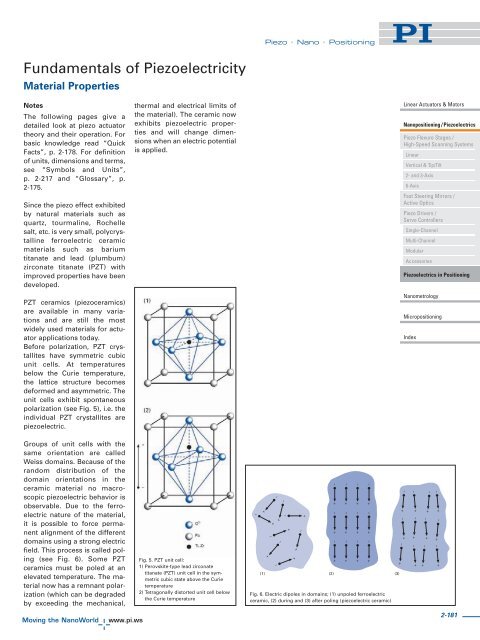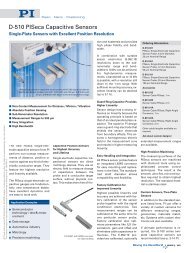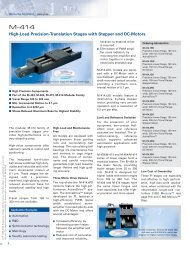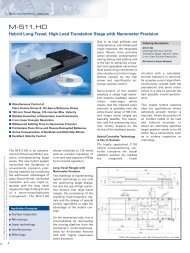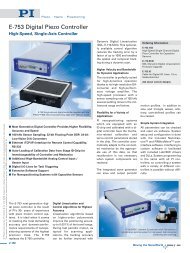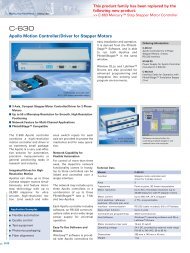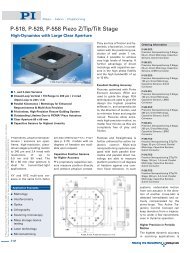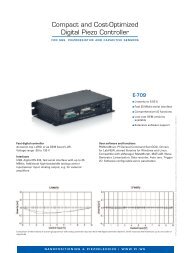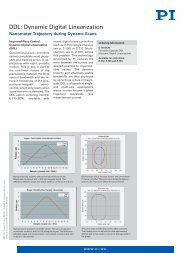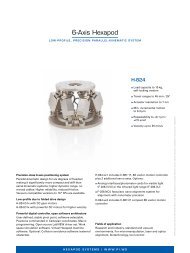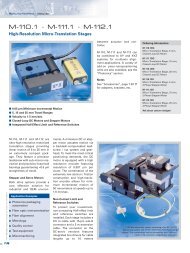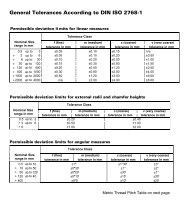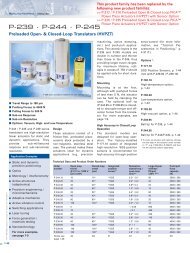Piezoelectrics in Positioning - PZT & Piezo Actuators: Sub ...
Piezoelectrics in Positioning - PZT & Piezo Actuators: Sub ...
Piezoelectrics in Positioning - PZT & Piezo Actuators: Sub ...
Create successful ePaper yourself
Turn your PDF publications into a flip-book with our unique Google optimized e-Paper software.
<strong>Piezo</strong> • Nano • Position<strong>in</strong>gFundamentals of <strong>Piezo</strong>electricityMaterial PropertiesNotesThe follow<strong>in</strong>g pages give adetailed look at piezo actuatortheory and their operation. Forbasic knowledge read “QuickFacts”, p. 2-178. For def<strong>in</strong>itionof units, dimensions and terms,see “Symbols and Units”,p. 2-217 and “Glossary”, p.2-175.S<strong>in</strong>ce the piezo effect exhibitedby natural materials such asquartz, tourmal<strong>in</strong>e, Rochellesalt, etc. is very small, polycrystall<strong>in</strong>eferroelectric ceramicmaterials such as bariumtitanate and lead (plumbum)zirconate titanate (<strong>PZT</strong>) withimproved properties have beendeveloped.<strong>PZT</strong> ceramics (piezoceramics)are available <strong>in</strong> many variationsand are still the mostwidely used materials for actuatorapplications today.Before polarization, <strong>PZT</strong> crystalliteshave symmetric cubicunit cells. At temperaturesbelow the Curie temperature,the lattice structure becomesdeformed and asymmetric. Theunit cells exhibit spontaneouspolarization (see Fig. 5), i.e. the<strong>in</strong>dividual <strong>PZT</strong> crystallites arepiezoelectric.thermal and electrical limits ofthe material). The ceramic nowexhibits piezoelectric propertiesand will change dimensionswhen an electric potentialis applied.L<strong>in</strong>ear <strong>Actuators</strong> & MotorsNanoposition<strong>in</strong>g / <strong><strong>Piezo</strong>electrics</strong><strong>Piezo</strong> Flexure Stages /High-Speed Scann<strong>in</strong>g SystemsL<strong>in</strong>earVertical & Tip/Tilt2- and 3-Axis6-AxisFast Steer<strong>in</strong>g Mirrors /Active Optics<strong>Piezo</strong> Drivers /Servo ControllersS<strong>in</strong>gle-ChannelMulti-ChannelModularAccessories<strong><strong>Piezo</strong>electrics</strong> <strong>in</strong> Position<strong>in</strong>gNanometrologyMicroposition<strong>in</strong>gIndexGroups of unit cells with thesame orientation are calledWeiss doma<strong>in</strong>s. Because of therandom distribution of thedoma<strong>in</strong> orientations <strong>in</strong> theceramic material no macroscopicpiezoelectric behavior isobservable. Due to the ferroelectricnature of the material,it is possible to force permanentalignment of the differentdoma<strong>in</strong>s us<strong>in</strong>g a strong electricfield. This process is called pol<strong>in</strong>g(see Fig. 6). Some <strong>PZT</strong>ceramics must be poled at anelevated temperature. The materialnow has a remnant polarization(which can be degradedby exceed<strong>in</strong>g the mechanical,Fig. 5. <strong>PZT</strong> unit cell:1) Perovskite-type lead zirconatetitanate (<strong>PZT</strong>) unit cell <strong>in</strong> the symmetriccubic state above the Curietemperature2) Tetragonally distorted unit cell belowthe Curie temperatureFig. 6. Electric dipoles <strong>in</strong> doma<strong>in</strong>s; (1) unpoled ferroelectricceramic, (2) dur<strong>in</strong>g and (3) after pol<strong>in</strong>g (piezoelectric ceramic)2-181


